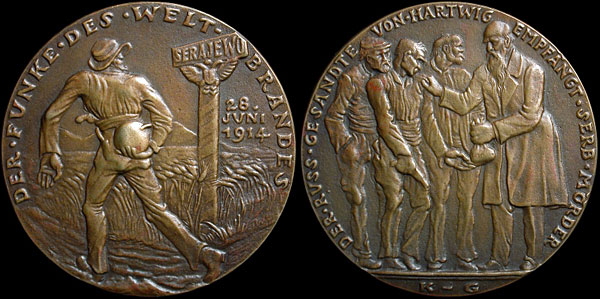
K-132
THE RUSSIAN AMBASSADOR RECEIVES THE SERBIAN ASSASSINS
(Serajewo, Der Funke des Weltbrandes)
1914 Cast Bronze, 58.0mm, Wt. 54.60g, Frankenhuis 1412
Obverse: An armed assassin with pistol in belt and a bomb behind his back, marches left past the Sarajevo city marker. Along the rim of the medal is written; DER FUNKE DES WELTBRANDES 28 JUNI, 1914. (The spark of the world fire, June 28, 1914).
Reverse: A group of men in the center surrounded by rim text reading; DER-RUSS-GESANDT VON-HARTWIG EMPFANGT-SERB -MÖRDER (The Russian Ambassador von Hartwig receives Serbian Murderers). K-G in exergue.
----------
On October 6, 1908, Austria annexed Bosnia and Herzegovina directly into the Austro-Hungarian empire. This didn't go over well with Russia who felt they were snubbed when Austria didn't help Russia acquire the Dardanelles. Of course, the Serbs were livid since they wanted the lost provences for their own Serbian empire.
Goetz apparently wants full responsibility placed on the Russians for the assassination of Austrian Archduke Franz Ferdinand as evidenced by his design showing the Russian Ambassador, Nikolaus von Hartwig, handing over a bag of money to the three trained assassins; Gavrilo Princip (the gunman), Nedjelko Cabrinovic (the bomber), and Trifko Grabez. For more on this fateful day please go to WWI-Sarajevo for a concise and well written description.
----------
One of Goetz' design vehicles is to show people of eastern European descent as almost sub-human entities with exaggerated head and body features like brawny, thick shoulders; large, clumsy hands; flat and angular heads with big ears, noses, etc.. By using these crude characterizations he successfully plays to the viewers visceral emotions that this is a dark and untrustworthy ethnic group. See K-222 for another example of this technique.